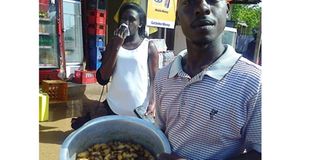Kalangala to start rearing, exporting edible beetles

Kalangala District has introduced a programme to rear, process and export edible huhu grubs.
The insects, which have a resemblance to queen ants, are found in bush oil palm plantations, and are eaten as a delicacy in Ssese Islands.
They are so valued that they are even used as barter commodities in bride price negotiations and other cultural ceremonies.
Emmanuel Ssekimpi from Bumangi Mugoye Sub-county states that huhu grub beetles have always been part of the lives of inhabitants of the islands.
Source of income
However, with the decline in their numbers, goats and cows are the substitutes exchanged as bride price.
But now, according to Tadeo Mwesige, the district production and natural resources officer, the beetles are being looked at as a source of income from exports especially to The Netherlands, Sweden and many parts of the Middle East.
“The market has readily been established in the Middle East, Europe and China. Since we have the bush oil palm plants available, we only need to ensure production of the insects,” he said.
Increase production
Mid last year, residents of the district through the Community Transformation Foundation Network requested the National Environment Management Authority (Nema) to allow them start growing the trees so as to increase the production.
Edible huhu grubs are on the verge of extinction due to severe destruction of the wetlands. And since the start of the oil palm project in 2008, a significant number of bush palm oil trees were cut down.
This is as the reason why the insects are hardly adequate for trade and consumption.
“Even those trees that were planted in wetlands were cut down leaving us vulnerable. We can no longer get enough of beetles,” says Emmanuel Lugambiso, one of the residents who is rearing the beetles.
The grubs are a stage of development for beetles, locally known as mpalanda. They live in decomposing stems of bush oil palm trees. Each mpalanda can produce up to 120 grubs and take a period of 13 days to becomes beetles.
Mwesige indicated that processing plants will be constructed in different localities to prepare the grubs which have been harvested for export.
Last year, Yisto Kayiga Mudde, the Masaka region coordinator, Slow Food International, led a team of food analysts to investigate the export potential.
Exploit potential
He noted that there is also a need for the various concerned parties to reclaim this cultural aspect of the Ssese identity.
“Nema should allow the people to grow bush palm oil trees in wetlands such that people can get back to the production of the food,” he said.
The grubs are also a source of cooking oil, which is got from their fat. On the islands, each grub goes for Shs500. However, a plateful is $20 (Shs69,460 at current exchange rate) at one of the hotels in Kalangala.
On the international market, the beetles are bought at $8 (Shs27,784) each, according to Mwesige.
“The potential we have is that we are able to get the yields within a short period of time. This is an incentive we expect to exploit so as all those who can rear can earn good prices for their products,” he said.
What are huhu grubs
Huhu beetle, Prionoplus reticularis, is a member of the longhorn beetle family Cerambycidae. A common name for the beetle is haircutter because of the long legs and antenna covered with sharp hooks.
The beetles are most active at night and are attracted by the lights of the dwelling and only live for about two weeks. They do not feed.
The whitish larvae are up to 70 mm long. Huhu beetle larvae are commonly known as huhu grubs. They hatch from eggs deposited under bark or in crevices in rotten wood.
For two to three years, they live in cavities they have eaten into the wood, then begin a pupal stage that lasts 25 days. They emerge as flying adult huhu beetles. For the little grubs to thrive, the moisture content of the wood has to be at least 25 per cent.




